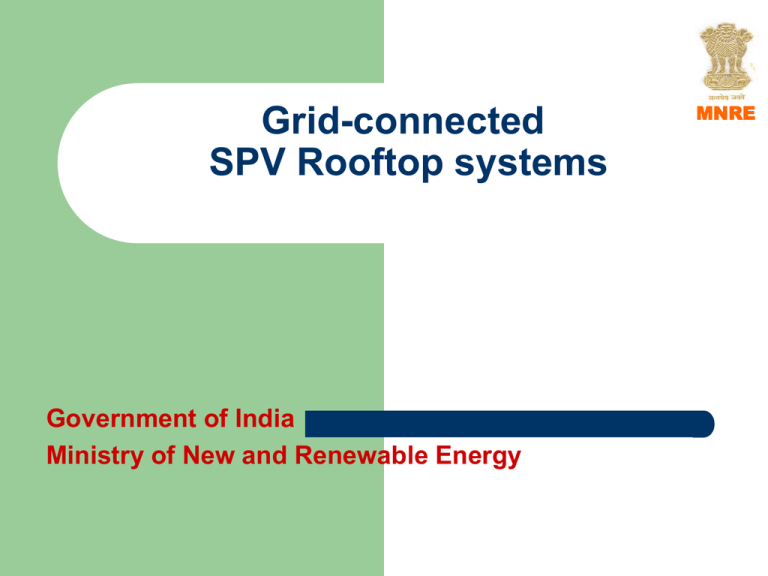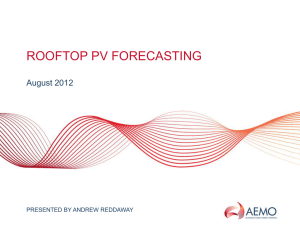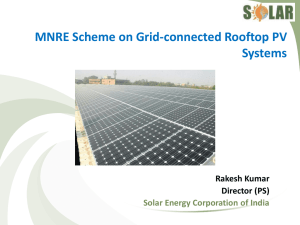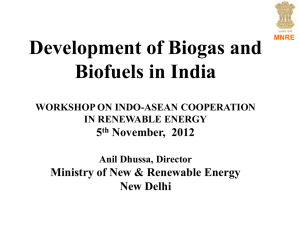Dr Arun Tripathi, Director, Ministry of Non
advertisement

Grid-connected SPV Rooftop systems Government of India Ministry of New and Renewable Energy MNRE Grid-connected SPV Rooftop systems MNRE Concept… These are SPV systems installed on rooftops of residential, commercial or industrial premises. Electricity generated could be… -fed into the grid at regulated feed-in tariffs or -used for self consumption with net-metering approach Grid-connected SPV Rooftop systems MNRE Concept… Grid-connected SPV Rooftop systems MNRE Advantages ….. Savings in transmission and distribution losses Low gestation time No requirement of additional land Improvement of tail-end grid voltages and reduction in system congestion with higher self-consumption of solar electricity Local employment generation Grid-connected SPV Rooftop systems MNRE Advantages ….. Grid-connected SPV Rooftop systems World-wide Experience ….. MNRE Germany, USA and Japan are leaders in adopting gridconnected SPV Rooftop systems. Germany has highest PV installed capacity of 32.8 GW of which 70% is in rooftop segment (as on 31.12.2012). Italy has 12.7 GW PV installation with over 60% rooftop systems In Europe of total 50.6 GW PV installation, over 50% in in rooftop segment. FIT is norm in Europe while net-metering is popular in USA. Grid-connected SPV Rooftop systems MNRE World-wide Experience ….. Germany <1% Building integrated PV market segments in Germany MNRE Image: Grammer Image : Schüco Private buildings: 1-10 kWp Social, commercial, agricultural buidlings: 10-100 kWp 10% Ground-mounted Image : Solarwatt 28% Large commercial buildings: > 100 kWp 38% 23% Rooftop 71% Image: Sharp Image : Geosol Image : Solarwatt Image: Geosol Image : BP Market share in % of MW installed in 2011 Source: BSW-Solar, E.Quadrat GmbH Germany …1000 Roofs Programme 1991-1995 MNRE Only German producers (local contentCapital Grant of 70% of investment provided(50% by the federation and 20% by Federal States) Grid connected PV installation with 1-5 kWp rooftops of single and two family houses were eligible Every installation had to install 3 meters: - Generation meter, metering at production - Feed-in-Meter, metering at fed electricity - Import Meter, metering the purchased electricity Obligation for installation operators to record over 5 years monthly meter results Germany …100,000 Roofs Programme 1999-2003 MNRE Loan Programme through KfW 300 MW of newly installed capacity from PV Loans at reduced rate of interest (soft loan) Interest rate of 1.91% Installations of min. 1kWp of individuals, Freelansers or SMEs PV rooftop Germany 2012 PV capacity (cumulative) until August 2012: 30,050 MWp Number of grid connected PV systems until August 2012: 1,223,000 Share of national gross electricity consumption: 10% Share of rooftop systems: 71% CO2 savings in 2011: 12.8 million t Source: BSW (German solar industry association) / official register of Bundesnetzagentur MNRE TOP 3 PV success factors in GermanyMNRE 1. EEG – Feed-in law (20 year state guaranteed FIT , RE feed-in priority, one simple national binding scheme) 2. Attractive business case for all kind of investors from house owner to international investment trusts created Long term & stable legal framework Non-recourse project financing enabled 3. Quality standards (establishment of high technical standards & development of qualified technical resources e.g. EPCs / integrators) Secure long term yields and system security Grid-connected SPV Rooftop systems World-wide Experience ….. USA Net metering is popular in 43 States but specific rules defer from States to States. Energy Policy Act 2005 mandates all public electricity utilities to make net metering options available to all customers. California had maximum installed onsite customer generated solar capacity of 991 MWp with 1,01,284 net metering consumers from 115000 sites. MNRE Net Metering mechanism MNRE The Net Metering mechanism shall allow the consumer to reduce its electricity import The utility benefits by avoiding purchase of electricity from short term market Electricity generation at load center also minimises the loss of electricity in wires Capacity for development under Net Metering Mechanism may be allowed in phases to take care of the following aspects. • Equivalent to suitable percentage the utility propose under the intra state network losses or • Capacity projected for purchase of Short Term market • Financial viability Business Models for Net Metering – 1 MNRE Consumer end model Consumers are owners of the facility C1 Challenges: C2 Limited know-how of installing and operating Limited know-how for requirements of approvals and clearances Administration cost of utility may increase Utility needs to interact with consumers, energy accounting on individual basis DISCOM C3 Cn Business Models for Net Metering – 2 Capacities may be bundled by a facilitator/ representative who undertakes necessary formalities and may avail subsidy for consumers Administration cost of utility less compared to earlier model Utility needs to interact with facilitator/ representative of consumers/owners Representative Consumer end Community based model MNRE C1 C2 DISCOM C3 Energy accounting at community level Sharing of benefits among consumers may take place on the basis of their contribution Cn Business Models for Net Metering – 3 RESCO/3rd party model based on FIT RESCO/3rd party shall supply electricity to the DISCOM at determined FIT DISCOM MNRE DISCOM may also call for competitive bidding for selection of RESCO/3rd Party C1 RESCO makes investments for installing facilities at consumers’ roof C2 Consumers get suitable rent for lending their roofs 3rd Party C3 3rd Party gets subsidy from the MNRE Energy accounting takes place at consumer end Utility purchases solar electricity for meeting RPO Cn Emerging Market Models for Net Metering – 4 3rd Party model based on consumer tariff bidding Selection of RESCO/3rd Party at DISCOM upper cap estimated by DISCOM Consumer gets net energy metered at its premise Consumers get suitable rent for using their roofs which shall reflect 3rd in their electricity bills Party 3rd Party gets subsidy from MNRE MNRE C1 C2 C3 Streams of revenue include, Sale of electricity to DISCOM Sale of RECs Tax Benefit, Accel. Depreciation benefit etc. Cn Consumer tariff assumed to be increasing Grid-connected SPV Rooftop systems Indian Experience: Initiatives by West Bengal Grid connected rooftop is allowed only for institutional consumers with 2-100 kW size Connectivity is allowed at low or medium voltage(6 kV or 11 kV) of distribution system Solar injection is permitted only upto 90% of annual electricity consumption. Net energy supplied by the utility to be billed as per existing slab tariffs. Solar generation to offset consumption in the highest tariff slab and then the lower slab. MNRE Grid-connected SPV Rooftop systems Indian Experience: Initiatives by West Bengal MNRE As per recent policy All existing and upcoming commercial and business establishments having more than 1.5 MW contract demand to install SPV rooftop systems to meet at least 2% of their total electrical load All existing and upcoming schools and colleges, hospitals, large housing societies, and and Govt. establishments having more than 0.5 MW contract demand to install SPV rooftop systems to meet at least 1.5% of their total electrical load. Policy targets 16 MW of rooftop and small PV installations by 2017. Grid-connected SPV Rooftop systems Indian Experience: Initiatives by Gujarat MNRE Gandhinagar city initiated a 5 MW(4 MW in Govt. buildings and 1 MW in private homes) rooftop PV programme based on FIT/sale to utility. Two project developers for 2.5 MW each selected through reverse bidding with GERC cap of rs. 12.44/kwh. Torrent Power will buy from Azur @ Rs. 11.21/kWh for 25 years and Azure will pass on Rs. 3.0/kWh to rooftop owner as roof rent. Recently 5 more cities-Bhavnagar Mehsana, Rajkot, Surat and Vadodara started installing pilot rooftop projects. Grid-connected SPV Rooftop systems MNRE Indian Experience: Initiatives by Karnataka As per new RE policy 2009-14, State to promote rooftop with net metering. System size to be 5-100 kW and interconnection at 415 V, 3 phase or 11 kV. Maximum energy injection allowed upto 70% of energy usage at site from DISCOM. Energy injection to be settled on net basis in each billing period, no carry forward. Grid-connected SPV Rooftop systems MNRE Indian Experience: Initiatives by Karnataka 25000 PV rooftops of 5-10 kWp size with net metering targeted during next 5 years with 250 MW potential and 350 MU generation. Grid connected PV rooftop projects to be given priority under Green Energy Fund. Pilot projects may come up in Mysore and Hubli-Dharwad solar cities. Grid-connected SPV Rooftop systems MNRE Indian Experience: Initiatives by Tamil Nadu As per ‘State Solar Policy 2012’ 350 MW SPV rooftop targeted during 2012-2014. 50 MW rooftop to be supported through GBI @ Rs. 2.0/kWh for the first 2 years, Rs. 1.0/kWh for the next 2 and Rs. 0.50/kWh for other 2 years. Net metering will be allowed at multiple voltage level Grid-connected SPV Rooftop systems MNRE Indian Experience: Initiatives by Tamil Nadu Interconnection to be as follows: < 10 kW - connection at 240 V 10 to 15 kWp - connection at 240/415 V 15 to 50 kWp - connection at 415 V 50 to 100 kWp - connection at 415 V 100 kWp - connection at 11 kV Exemption from payment of electricity tax will be allowed for 5 years for 100% solae electricity used for self/sale to utility. All new Govt./Local body buildings shall necessarily install PV rooftops. Grid-connected SPV Rooftop systems MNRE Indian Experience: Initiatives by Chandigarh 1.14 MW projects of SPV grid connected PV rooftops projects sanctioned for model solar city are under installation of which 50 kW commissioned. DISCOMS agreed to purchase power and rates yet to be finalised. Grid-connected SPV Rooftop systems MNRE Indian Experience: Initiatives by Chandigarh Interconnection to be as follows: -Upto 10 kW : Low voltage single phase -10 kW to 100 kW :3 phase low voltage supply -100 kW to 1.5 MW : Connection at 11 kV level -1.5 MW to 5.o MW : Connection at 11 kV/33 kV/66kV as per site conditions Grid-connected SPV Rooftop systems Indian Experience: Initiatives by Kerala 10,000 solar PV rooftops recently launched with 1.0 kWp each system of total 10 MW At present only off grid system covered but Kerala has plans to launch 75,000 grid connected rooftops soon. Rs. 39,000/- state subsidy is available for each 1.0 kWp system Major Issues…. Notification of “Technical Standards for connectivity of the Distributed Generation Resources Regulation- 2012 by M/o Power. Norms for capacity restrictions (kWp) for connectivity at each voltage level Tariff fixation by CERC/SERCs with or without subsidy/incentives. Metering system, position of meters, authentication mechanism etc. RPO and REC issues connected with grid connected SPV Rooftops MNRE Grid-connected SPV Rooftop systems MNRE Action being initiated ….. CEA has finalised “Technical Standards for Connectivity of the Distibuted Generation Resources-CEA Regulations 2012” and is sending to M/o Power for notification. CEA constituted a committee for amendment in “CEA Installation and Operation of MetersRegulation 2006” for for metering arrangement for inter connection of SPV rooftop with grid. CERC will soon bring out the guidelines for grid connectivity and metering arrangements for SPV rooftops. Grid-connected SPV Rooftop systems MNRE Action being initiated ….. MNRE has included Grid connected SPV rooftops in the “off grid and decentralised solar Applications” scheme vide ammend no. 5/23/2009-P&C dated 30th October 2012 for SPV plants upto 100 kW capacity. MNRE subsidy upto 30% on the following benchmark cost of the projects is available : Upto 5 kWp : 160 Rs./Wp 5 to 100 kWp : 140 Rs./Wp 100 to 500 kWp : 130 Rs./Wp A separate scheme to come up on “Grid connected SPV rooftops” during 2013-14 Grid-connected SPV Rooftop systems MNRE Action being initiated ….. NCEF has sanctioned 10 MW SPV grid connected rooftop project with 70.50 crore which is being implemented by SECI SECI has invited RFS for six cities namely Delhi(1MW), Bhubaneswar/Cuttack(1MW), Raipur/Naya Raipur(2MW), Gurgaon(2MW), Channai(2MW), Bangaluru(2MW). Grid-connected SPV Rooftop systems MNRE Actions required by States… States to announce suitable policies on grid connected PV rooftop systems States to establish dialogue with DISCOMs and finalize suitable tariff. DISCOMs to formulate and sign PPAs, States to set up few pilot projects. Roof Space requirement for rooftop system 15-20 sq. meter roof space is required for 1.0 kW system A 100 sq. meter roof space can have 5- 6 kW SPV system Cost of 1.0 kW system is about Rs. 1.50 to 1.60 lakh MNRE Potential of SPV rooftop MNRE One million industrial units and each with average 500 sq. meter rooftop space can have about 25,000 MWeq Solar PV rooftop installations. Only 800 Kendriya Vidyalayas in India can host about 20 MW eq. Solar PV rooftops. About 100 million houses can install 100 million 100,000 MW eq. Solar PV rooftops. ……and so on MNRE Thank You







